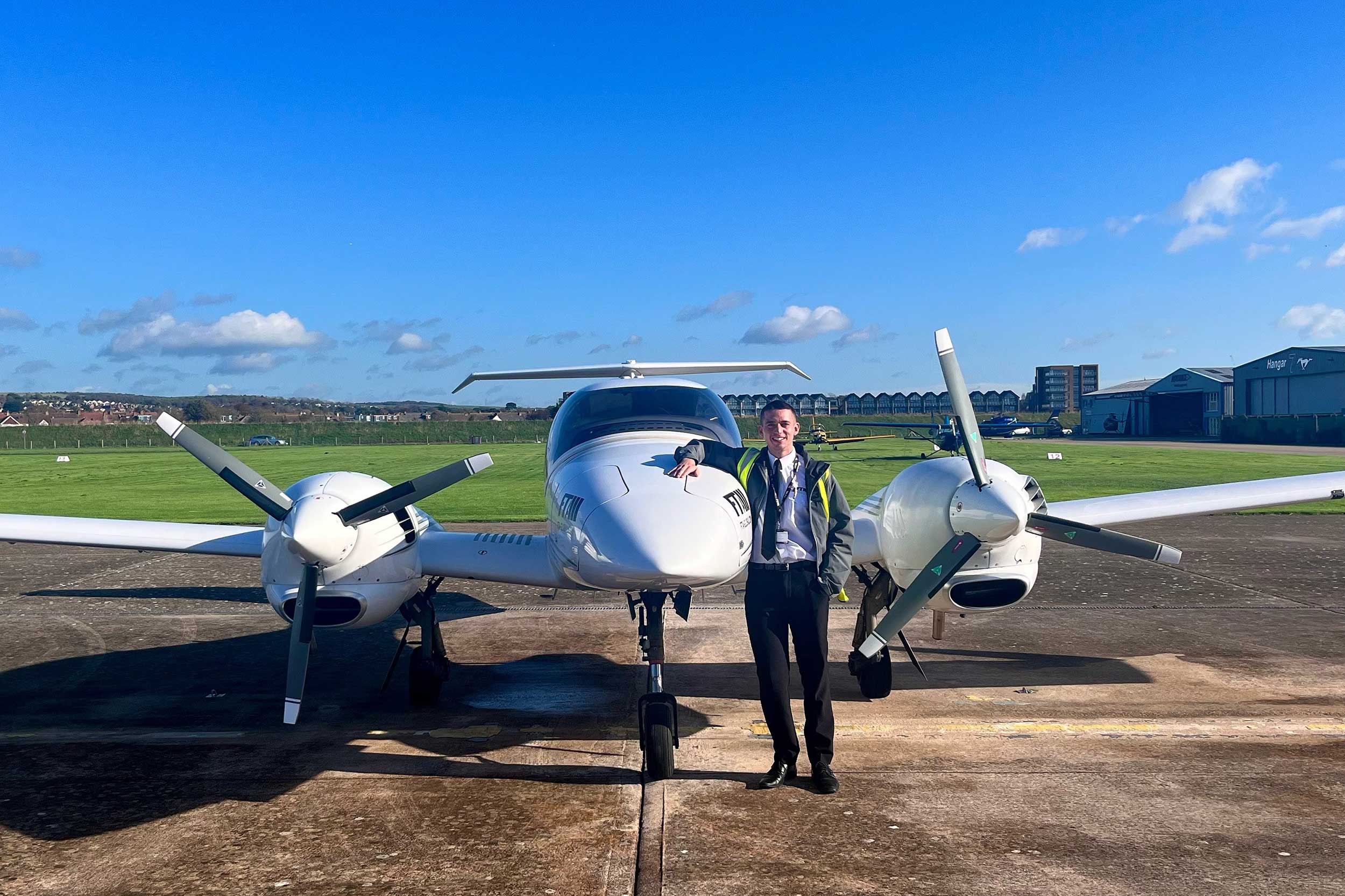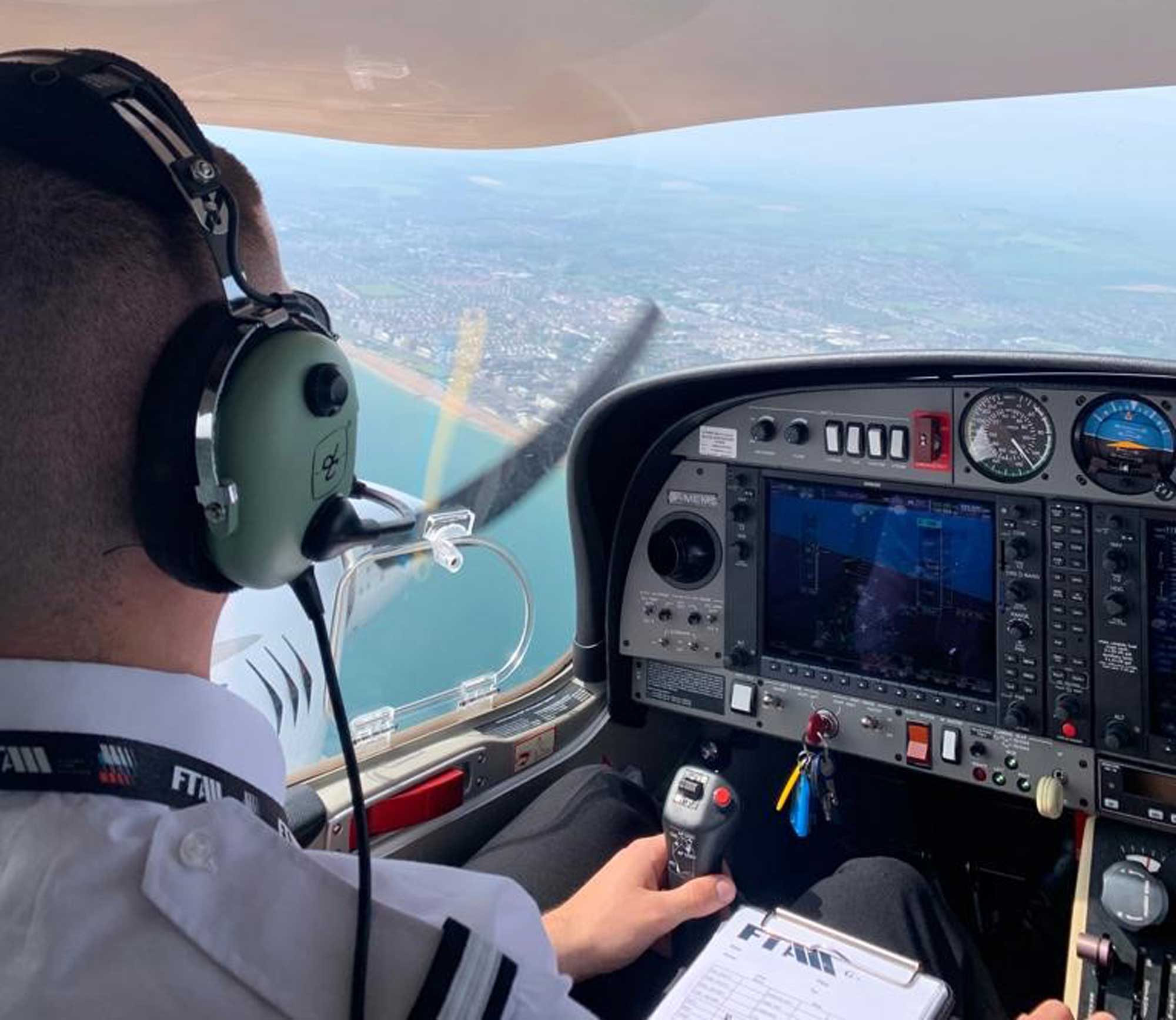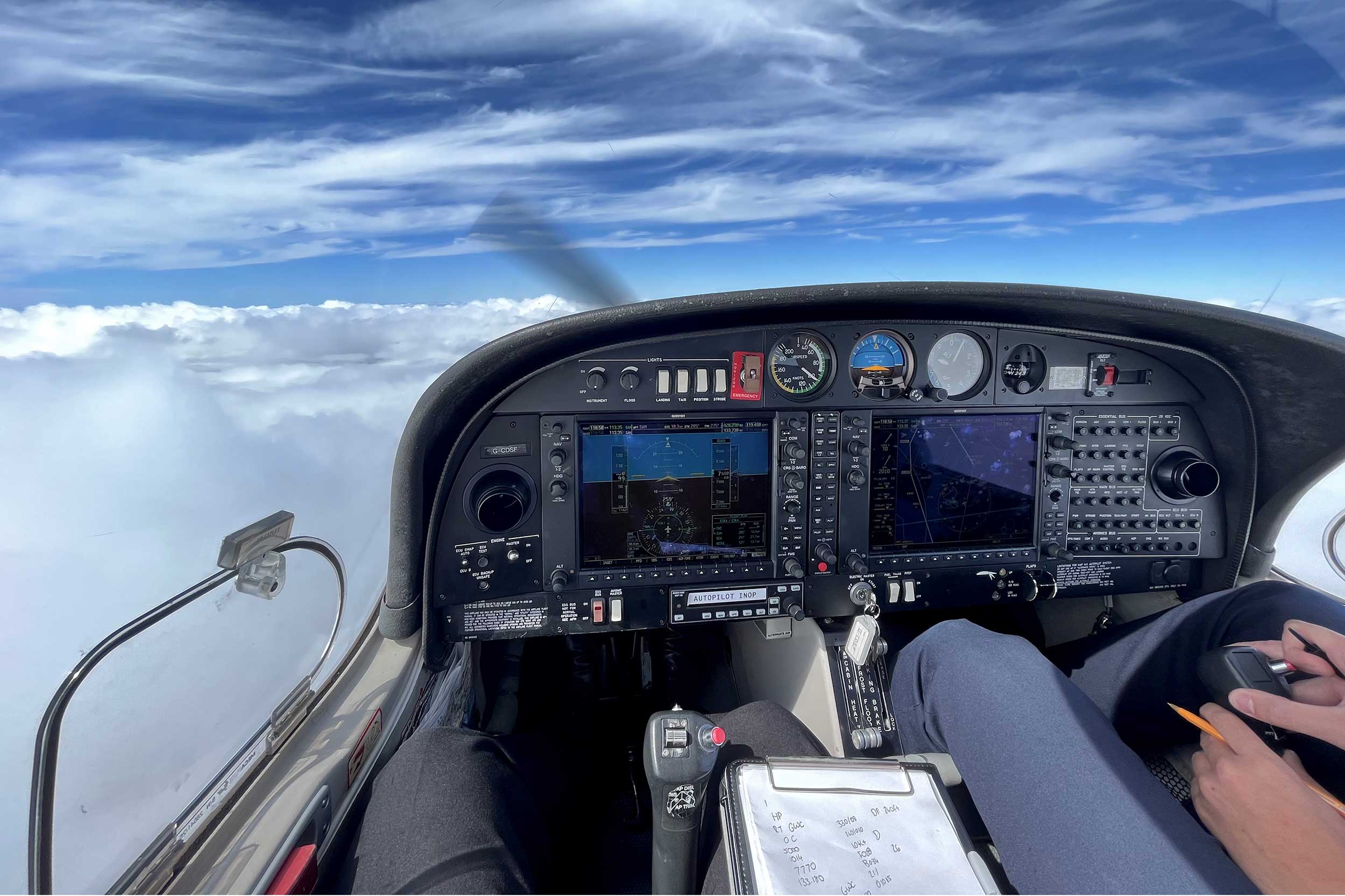
Joe Beresford – now a CAA/EASA qualified pilot – with one of FTA’s Diamond DA42 training aircraft at Brighton City Airport. Photos: FTA
PARTNER CONTENT The first UK flight school to offer UK CAA and EASA dual licence pilot training was FTA Global based at Bright City Airport. We spoke to 24-year-old Joe Beresford, from Solihull, on why he chose that route
What made you want to become a professional pilot?
It’s been a dream from an early age. I grew up in a village under the final approach to Runway 33 at Birmingham Airport so spent most of my childhood looking out my bedroom window watching aircraft take off and landing. As I grew older, I developed a deep passion for aviation and travel. Couple that with the fact I’d prefer not to work a 9-5 job, it seemed a perfect fit.
Do you have any previous aviation experience?
I had very little hands-on flying experience prior to joining FTA. I always knew I wanted to follow the integrated route, so gaining my flying hours wasn’t necessary. When I turned 17, I was faced with the choice of paying for flying lessons or learning to drive – I chose the latter. After finishing my A-Levels I worked full time at a local restaurant to earn some money. Around the time I turned 19 the ground handling agents at Birmingham Airport had a big recruitment drive. I applied for a job as an aircraft dispatcher and worked there for 18 months in total.
After 12 months I was trained in Load Control for Turkish Airlines and Aer Lingus. It’s a job I absolutely loved and can highly recommend to anyone, especially if you are young or looking to gain experience in the industry. It’s a high-pressure job, liaising with every single role required during an aircraft turnaround. The job taught me so much about how airlines and airports operate, giving me invaluable experience to take into my training and future career.
Why did you choose FTA?
Firstly, they offered 100% UK based training. This was important to me as I wanted to remain in one location to complete my training.
Secondly, competitive pricing compared to other Integrated courses in the UK.
Finally, and the biggest pull by far, was the family feel it had whilst looking round. Everyone was friendly and knew each other’s names, and they all seemed approachable – from the head of training to each individual student. Also, the feeling of being more than just a number, knowing I could have my progress tracked with instructors before each lesson, so that I knew any areas I needed to focus on.

One benefit of being based at Shoreham is that it’s easy to fly over to Europe and back for EASA training
Did the location at Bright City Airport (Shoreham) influence your decision?
Of course! As previously mentioned, the training being completely UK based was a big factor, but also the location of Shoreham seemed the right fit for me.
Being on the coast, Shoreham has its own microclimate which requires both students & instructors to be flexible with their plans. I think this comes into its own towards the end of training when you are doing the instrument rating, because students must use their own knowledge and experience to determine whether or not it is safe to fly. I also gained a lot of exposure to navigating through or around certain airspace with Gatwick to the north and Southampton out to the west.
Finally, the lifestyle the local area offers is amazing. I ended up moving into a flat in Hove with two course mates, Kate and Michael. We are all a similar age, so living in Hove meant there were plenty of places to eat, drink and just do fun activities. It allowed us to escape from what is a very intense course when we needed to.
The big question! Why did you decide to do the Dual Licence (CAA and EASA) course?
So, for a bit of context, the offer of doing both a UK and EASA licence was first mentioned in early 2021. At the time, we had just entered our second lockdown in the UK and job opportunities for cadets were bleak to say the least. This meant that I wanted to keep as many opportunities available to me as possible.
At the time there was a lot of uncertainty as to whether the UK CAA and EASA would come to an agreement with many rumours going around. Airlines such as EasyJet nd Ryanair had aircraft registered in both the UK and Europe, with it also being unclear as to whether they were going to expand their European/UK registered airlines.
As we had paid for only one set of theory and skills tests, FTA offered us the option of doing both for an additional charge to cover the extra ATPL theory exams and IR skills test. They estimated the cost in the region of £2,500.
At the time I was very unsure about what to do, but it was very well put by a fellow student, Josh, who said not doing both would basically be like gambling your course fee (£77,950) on the UK and EASA coming to some sort of agreement allowing pilots to fly each other’s registered aircraft.
This way of thinking about it was pivotal for me. I opted for the dual licence to give myself the best possible opportunity when I came to looking for my first job. At the time of making the decision, job prospects weren’t looking good so giving myself any sort of advantage could really make a difference.
It’s a choice I’m glad I made. I owe a huge thank you to Phil Jones, Head of Training at FTA, for the time/effort he put in during this period. He was providing us with all the latest information, advice and helping with processing such as SOLI (State Of Licence Issue) medical transfers. Also due to FTA’s location I was able to gain plenty of exposure to European Airspace prior to completing my EASA IR.

Flight training in FTA’s ‘glass cockpit’ Diamond DA40
Where are you in the training course now?
I completed my training with FTA at the end of October 2022. I now hold UK CAA and EASA Frozen ATPLs and am looking for my first job.
Why did you choose an integrated course?
It’s a decision I made early on whilst researching ATOs. The ATPL theory was something I was quite worried about, so having face to face classroom teaching was essential. I was also quite keen to get my training completed in the shortest possible timeframe, something the integrated course promised. Finally, I wanted to train with other students who were at similar stages of training – to compare notes with and help each other along the way.
How did the training go?
The overall training was good. I enjoyed my time at FTA. With the help of a fantastic group of theory instructors I was able to achieve first time passes on all my UK and EASA ATPL theory exams averaging over 90% for both. Thanks to guidance, tips and knowledge of the flight instructors, I passed both my CPL and IR Skills Tests first time too. It’s something I am extremely proud to achieve, also hopefully giving me the best possible chance at finding employment.
What has been the hardest part?
Easy – Covid. The coronavirus pandemic affected my training massively. I started my training in June 2020. ATPL theory is arguably the most challenging part of the course, so when factoring in an ongoing pandemic and uncertain future job market it started to affect my motivation. It took quite strict discipline & dedication to come out the other side.
I think the lowest point came in January 2021, after spending three months learning five new subjects, dedicating a lot of time to revision. I sacrificed a Christmas and New Year holiday with family and friends only for our exams to be cancelled by a lockdown a week before we were due to sit them.
See also: The big decision: Do I go for a UK or EASA licence?
What has been the most enjoyable part?
Besides the obvious – passing my CPL and IR Skills Tests – there is one flight that sticks out. Towards the end of my solo hour building phase, I had about 3.5 hours to make up to reach the minimum required for licence application.
I have family who live in a small town on the south coast of Devon, who I hadn’t seen for two years due to the pandemic. So, I decided to plan a long trip along the south coast in order to fly over so they could see me. I gave them a heads up I was coming, and when I arrived overhead, they were all there waving to me from the seafront. It’s a moment I’ll never forget and smile I had on way back to Shoreham stayed with me for a few days to come. The most enjoyable moment of my training by far!
Is there anything you’d change if you could?
Honestly, there’s nothing I’d want to change. If I was to do everything all over again, the only thing I would do is look into modular training more than I did. As I’d decided quite early that I wanted to follow the integrated route, it meant I discounted the modular options. So, I wish I’d have spent a little bit longer researching to see what options may have been available at the time.
Where do you hope to be in two years’ time?
Hopefully in the right-hand seat somewhere, closing in on my 1500th hour. Right now, I am looking at all options available to me. The more I have gone through training, the more I have learnt of the different opportunities out there. I would like to keep every door open as you never know where aviation might take you.¬
What advice would you give to anyone considering training as a professional pilot?
Do your research! Just because one route works for one person, doesn’t mean it will work for another. For example, UK based training worked for me, but others may want to compete their hour building in Europe or North America. Also, be sure to take a couple of trial lessons to make sure this really is for you! It might sound a bit obvious, but I have seen people go all the way through ground school, before reaching the flight training and halfway through realise this isn’t for them – a costly mistake.

